A 3500 Lumen Duty Light with a runtime of 1.25Hrs on high, Beam distance 452m, and 51,000 Candela (As claimed by Streamlight).
Rated IPX7 – 1 meter water for 30 minutes and 1 meter impact.
It has a Glass lens, TIR optic, 6000 series “aircraft” aluminum with anodized finish, C4 LED Technology, and a “sure grip rubber sleeve”.
Made in China.
Here’s a link to the Streamlight product fact sheet:
I found a good deal on this light at MidwayUSA ($73).
(Edit the typical price has now dropped to the low $70s)
I’ve been curious as to what the mainstream makers have been doing. So I thought I’d give one a try.
It is sold in two flavors. One has the light, (2) 18650s with built in charging ports and a USB cord. The second is the light with (4) 123s (for less $:money_mouth_face:. I got the latter.
Light and batteries

Opening the box I found the 123s in a Ziploc bag and the strap already attached. The batteries were not at full voltage. Cleary I got sent a returned unit. No biggie if it works.
As expected there is a nice box.

Specs on the outside.

Multi Fuel – Gas, Diesel, or Propane?
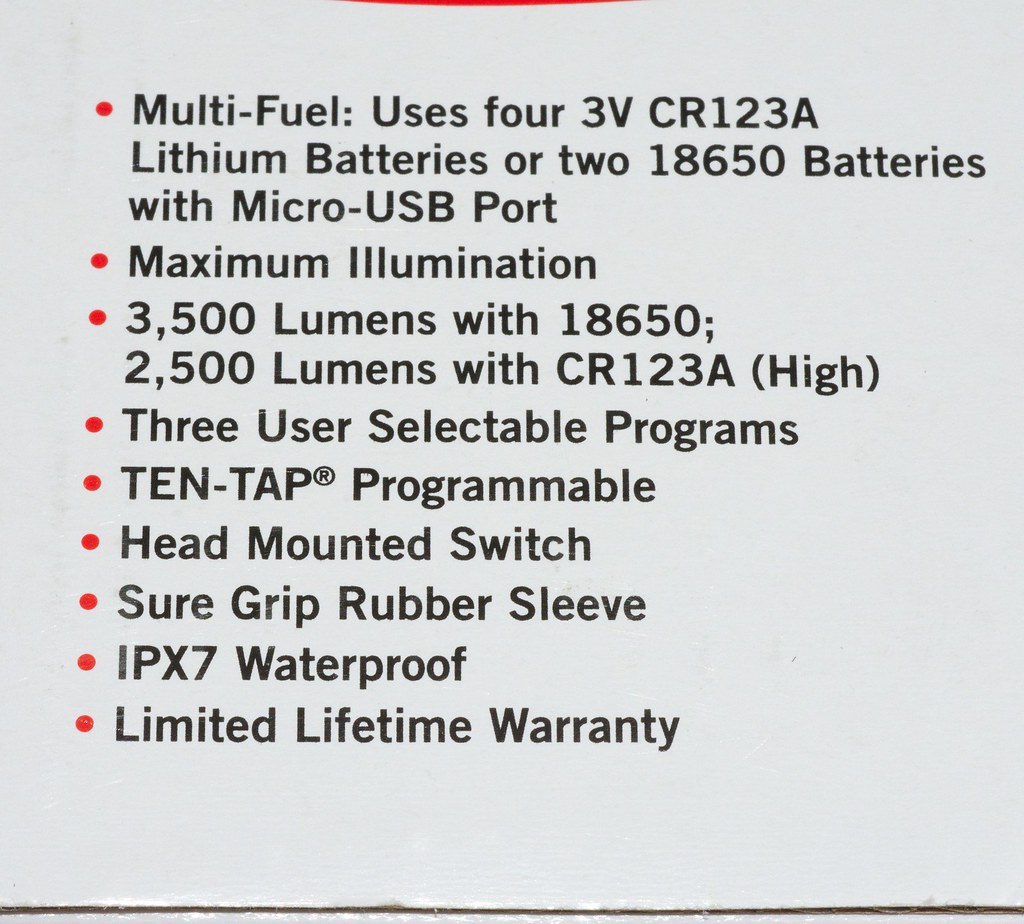

And we see a date of 3/19
I wonder if that’s for the light or the box?
The instruction sheet


The secret handshake to change programs.
Nine clicks then a hold do the trick.

Take a look at the “Lifetime Warranty”.
It covers everything except the stuff that will break, like “bulbs” (I wonder do LEDs count as bulbs?), switches, and electronics (which get 2 years). And you need proof of purchase!
And it doesn’t cover abuse or normal wear.
Not exactly a “if you break it we will fix it” warranty that ought to come from a US company selling a “Duty/Tactical/Operators/Ninja” light. And if you look in the right place, it’s made in China.
The Specs as I measured them
Length = 9.5” (241mm)
Head OD = 2.245” (57mm)
Lens (visible) OD = 1.795” (45.6mm)
Heat sink OD = 2.34” (59.5mm)
Switch OD = 1.716” (43.59mm)
Tube OD = 1.231” (31.26mm)
Metal at end of tube OD = 1.05” (26.67mm)
Battery tube ID = 0.751” (19.07mm)
Weight with batteries = 1Lb, 3.1oz.
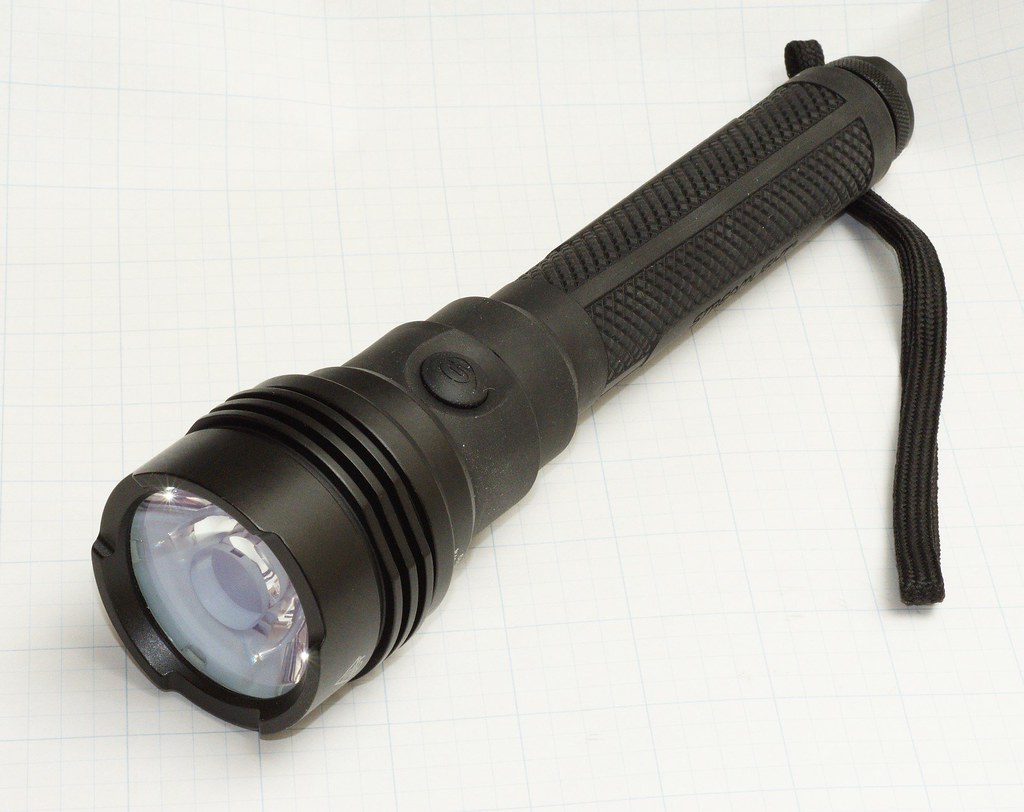
This is beefy for a 18650 light. For comparison a WOWTAC A4 is 0.9” (22.86mm) OD on the tube and is much lighter at 11.5oz. with batteries.
The end cap is not rubber coated. It has a single spring - tapering backwards from what we normally expect.
The threads and O-ring were dry and needed lubing. Even though the endcap and tube threads seem to be coated, the light can’t be locked out by unscrewing the cap. It remains on even with the O-ring well exposed. The threads are a fine pitch with sharp tops – not square cut.
End Cap

The tube and switch area are covered in a firm rubber. Think Hogue grips or inner tube.
There is texture on most of the tube. It gives a very secure hold.
Switch
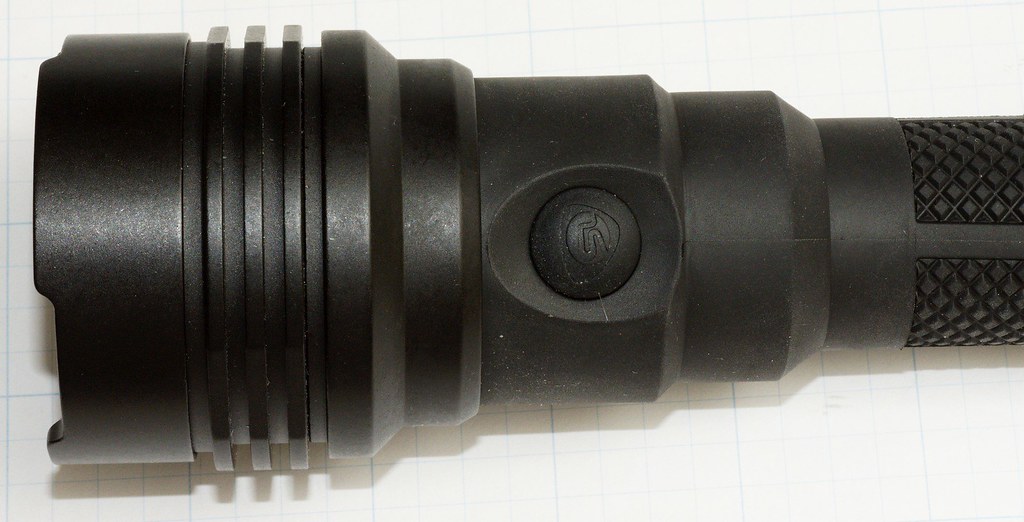
The head with the heatsink is not covered. There are crenulations on the rim. They are not sharp or deep (lawyer approved?). The purpose is, I assume, to let the user know if the light is on when placed face down on a flat surface.
The battery tube is hefty. It is a bit large for an 18650 at just over 19mm ID. No problems with fat cells getting stuck. The extra space makes me wonder if the batteries could get banged around if the light gets smacked around. Like maybe by the type of duty it’s expected to fulfill?
Batt Tube

Peering down the tube towards the business end I see a flat brass contact.
There are some projections on the side (to protect from reverse polarity?).
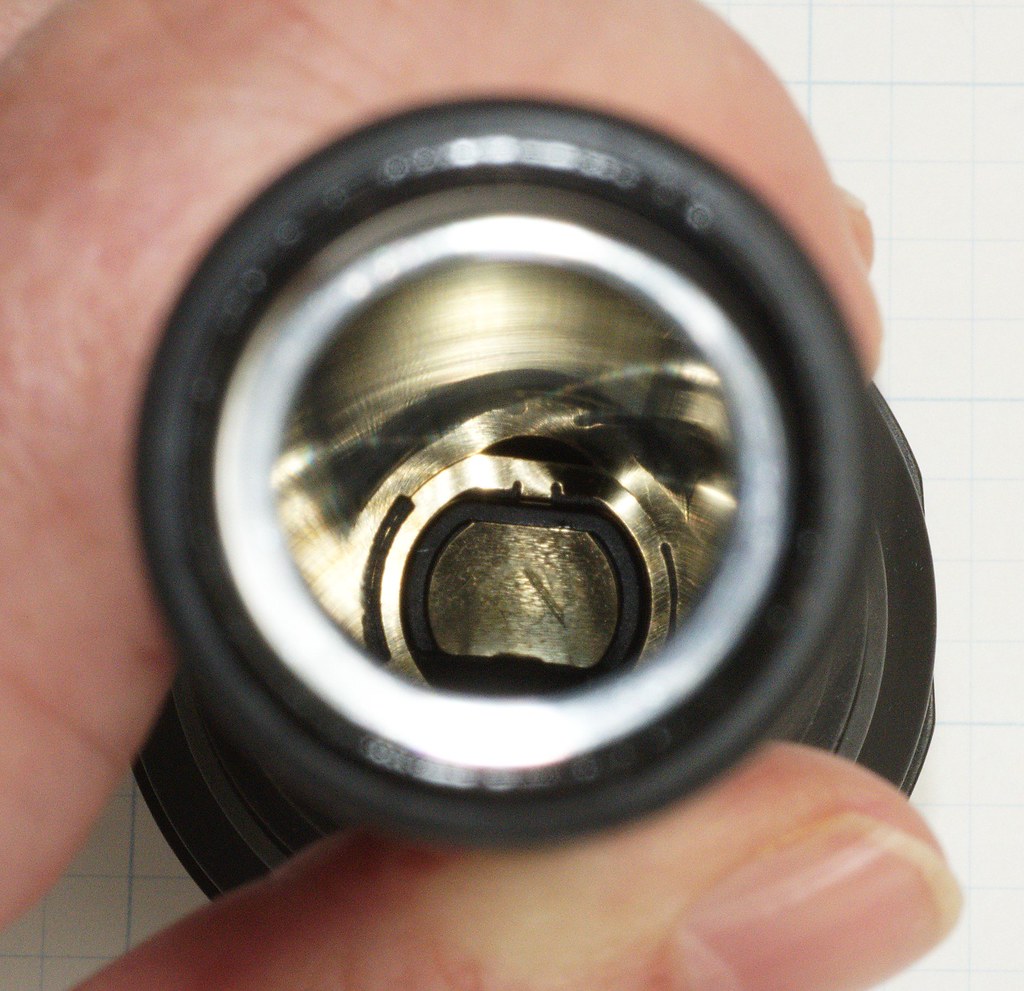
A flat top battery won’t work. A slight protruding flat top (like a Sanyo GA) also won’t make contact.
I used a magnet spacer for the Sanyo GAs and the Samsung 30Qs.
An additional spacer between the batteries is needed to make the battery stack (on the GAs) long enough to get a solid compression of the end cap spring.
Crying Big TIRs
The reason this light caught my interest was the optic. Instead of a reflector, the HL 5-X has a huge TIR on the front.
I really like my pocket lights with TIR lenses. I wanted to see what supersizing one was like. The head feels super solid.

The UI
This is a dead simple light. There are 3 programs to choose from.
High-Strobe-Low (the factory default).
High only.
Low-Med-High (the one I use).
There is no memory. So you always know what’s going to happen.
The switch is a forward clicky. Momentary flashes are easy.
A very quick half press before fully engaging the switch changes the modes.
A full click always turns the light on. A second full click always turns the light off.
Swapping between programs takes 9 fast clicks and a hold. It is unlikely that a program will get switched by accident.
Clearly the UI is designed for those who the light is a tool. Watching cop TV I see lots of clicking going on. Even with just limited choices they often end up in strobe mode when they don’t want it. The typical BLF light interface would end up in Never-Never Land if used this way.
The High, Strobe, Low makes a lot of sense for those who need such.
It could easily be renamed:
High - Where are you?
Strobe - Oncoming traffic don’t hit me!
Low - I’m searching your car where’s the dope?
I see in the instructions not to store or heat above 212F (!). I wonder if they had a problem with EMS types boiling their lights to sanitize them?
Some may lament the absence of an end cap switch. This lights predecessor the HL 4 has one. Some users have been fitting the HL 4 end cap (For that thumb action goodness).
I find end switches are less useful as the light gets longer and heavier. This one is about at the limit.
I find the light too long and head heavy to hold in the approved tactical cigar pose. Thumb on the tail cap, body between the first and middle fingers.
I hold the light with the head cupped in my hand and the switch falls under my finger. The traditional rest on the shoulder batter-up pose.
Runtime
On high using Samsung 30Q cells.
I decided that the max output is about 3200 Lumens. So that’s how I scaled the chart.
Please note that the lumens listed are for entertainment purposes only (Jeff Lumens).
Any relation to real lumens living or dead is purely coincidental.
The first 10 Minutes. No cooling.

The thermal stepdown starts at the 1 minute mark and slopes down to 5.5 minutes where it flattens out around 1850 Lumens.
Full Runtime. No cooling

At about 14 minutes the first plateau slowly drops and at about 18 minutes flattens out at about 1500 Lumens.
The light maintains this brightness until about 1Hr. 17Min. Then there is some chatter.
Is the driver trying to maintain the brightness and the batteries not quite making the grade?
Around 1Hr. 22Min. the batteries are getting tired and the light ramps down to a very low level of about 145 Lumens.
I switched it off just long enough to try to step it up to high again. It briefly jumped to 600 Lumens then dropped back to the 145 range.
I stopped the test at 1Hr 34Min. The batteries were at 3.15v.
PWM
Taking a look at the O-Scope – We see a current controlled light.
LOW
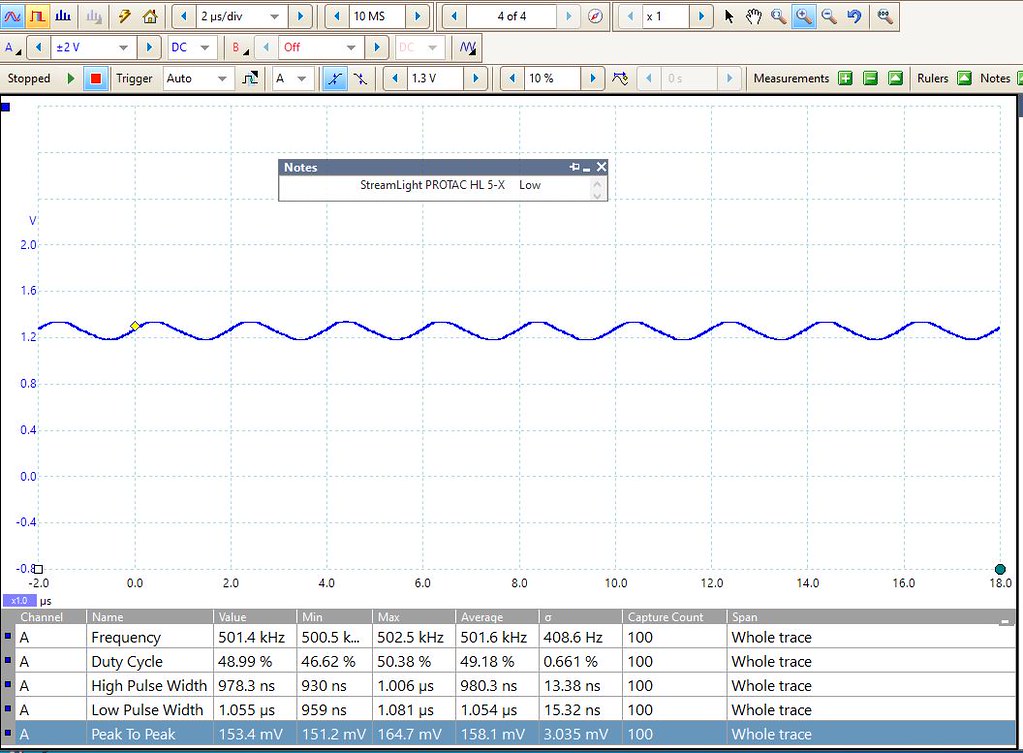
There is a DC offset. On low a 500KHz sine wave can be seen. This is an artifact of the driver.
Medium
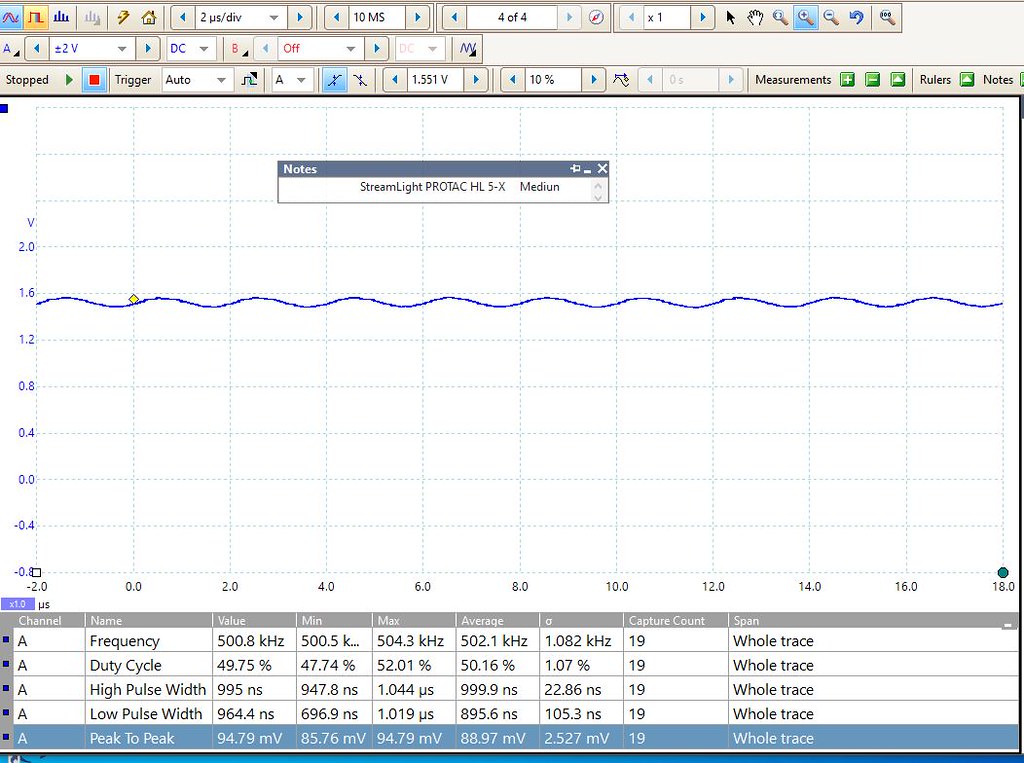
On Medium the 500KHz wave is starting to flatten out.
High
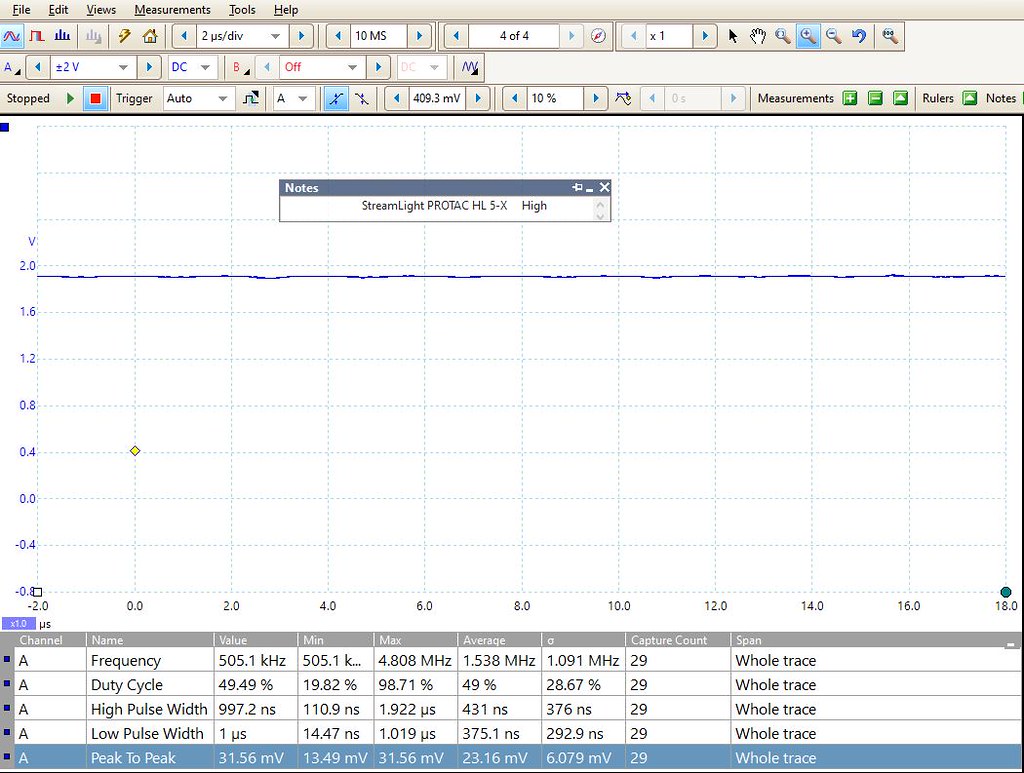
On High the scope can’t count a Frequency. Pretty close to a straight DC as far as I can tell.
Impressions
The switch takes a long press to engage and click on. It’s flat with the body. The long press should prevent accidental power ups. I wouldn’t trust it in a toolbox with a bunch of other stuff rattling around.
Using the light with heavy winter gloves might prove problematic. It’s also not easy to find the switch if I’m in fumble mode. With heavy gloves in the dark? F’gettaboutit.
The head feels sturdy and (should) take quite a beating before giving up the ghost. I wonder if the guts are potted? That would be a nice touch.
Some lights just feel right. This is one of them. The Convoy L6 and the Sofirn SP70 (both 2x 26650) feel heavy and clunky compared to the Streamlight. This one seems well balanced when carried in the Maglite “El Ka’bong” method.
The rubber coating and the hefty tube gives the impression that this light could take (or deliver) a beating.
As far as weight the SL HL 5-X is at or maybe above the limit of what could be comfortably hung on a duty belt (along with all the other crap). Some other lights for comparison.
0Lb, 4oz – Surefire G2 (2x132, old school incan)
0Lb, 6.7oz – Convoy C8 (1x18650)
0Lb, 11.5oz – WOWTAC A4 (2x18650)
0Lb, 14oz – Streamlight Stinger DS HPL (3x sub-C NiMH)
1Lb, 3.1oc – Streamlight HL-5X (2x18650)
1Lb, 10.2oz – Convoy L6 (2x26650)
1Lb, 14.5oz – Sofirn SP70 (2x26650)
2Lb, 8.4oz – Maglite (4xD cell, incan (the original El Ka’bong))
What’s it Look Like
The TIR gives a small-ish sized center spot with moderately defined edges.
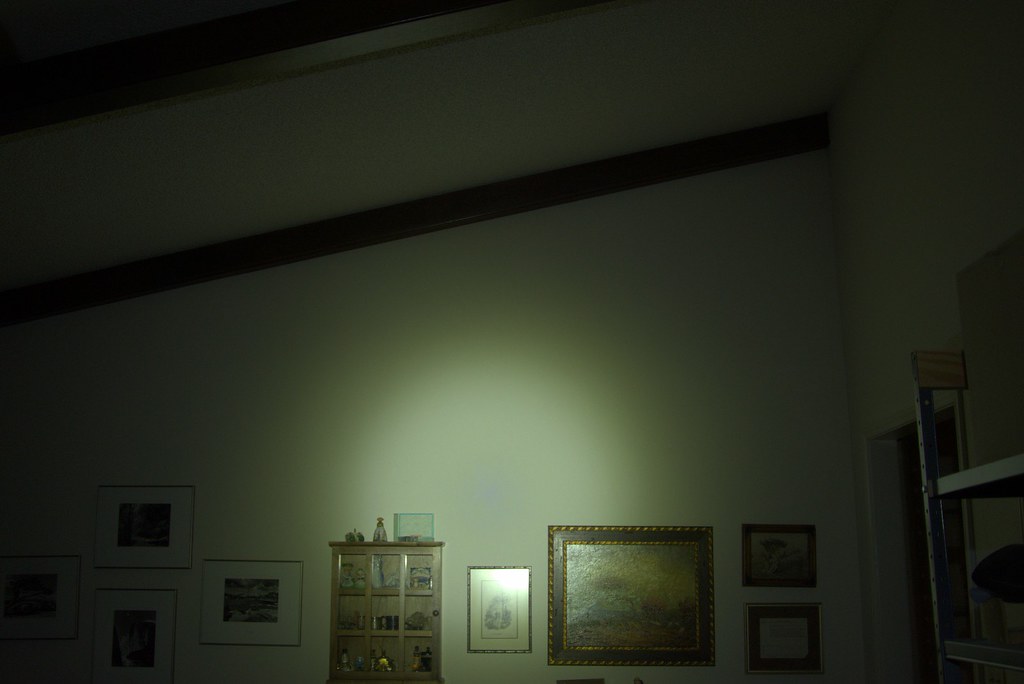
Much larger than a C8 with the SST40

The center spot is not as even as the one on my Olight TIR light.
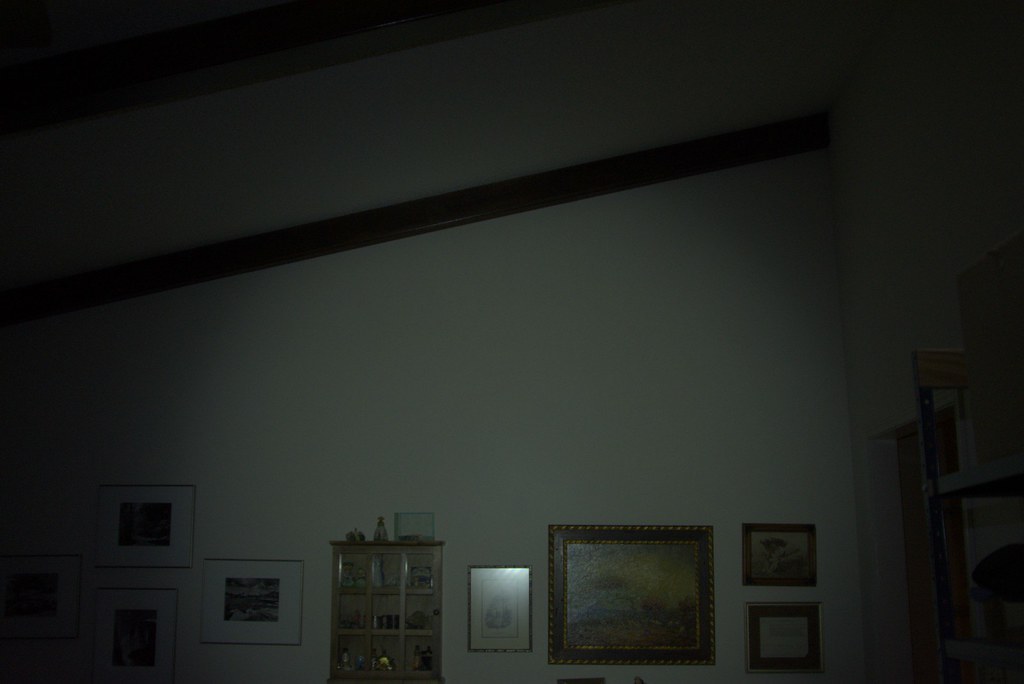
The Olight has a much broader center spot. The spill is fairly even.
At greater distances (and not white wall hunting) things even out more and it’s not as noticeable.
The very center of the spot has a blueish tint – at least to my eyes. I tried to capture this in some photos and it doesn’t show up well.
My Olight with a TIR also shows this blueish spot in the center.
Hulking Out
Around the outside of the center spot I see a greenish tint. Once again kind of disappointing. When photographing the beam, the green meanies really show up compared to other light.
Comparison shots
In all the shots the Streamlight is on the right.
ThorFire BLF Q8 vs Streamlight
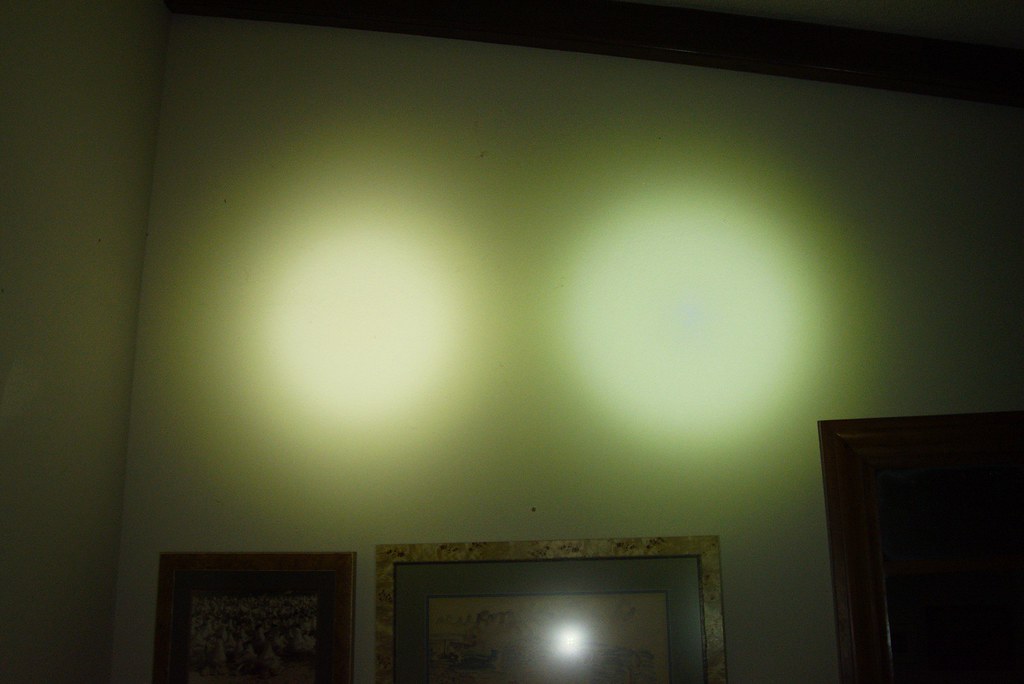
SL BLF SP36 (Samsung LEDs) vs Streamlight
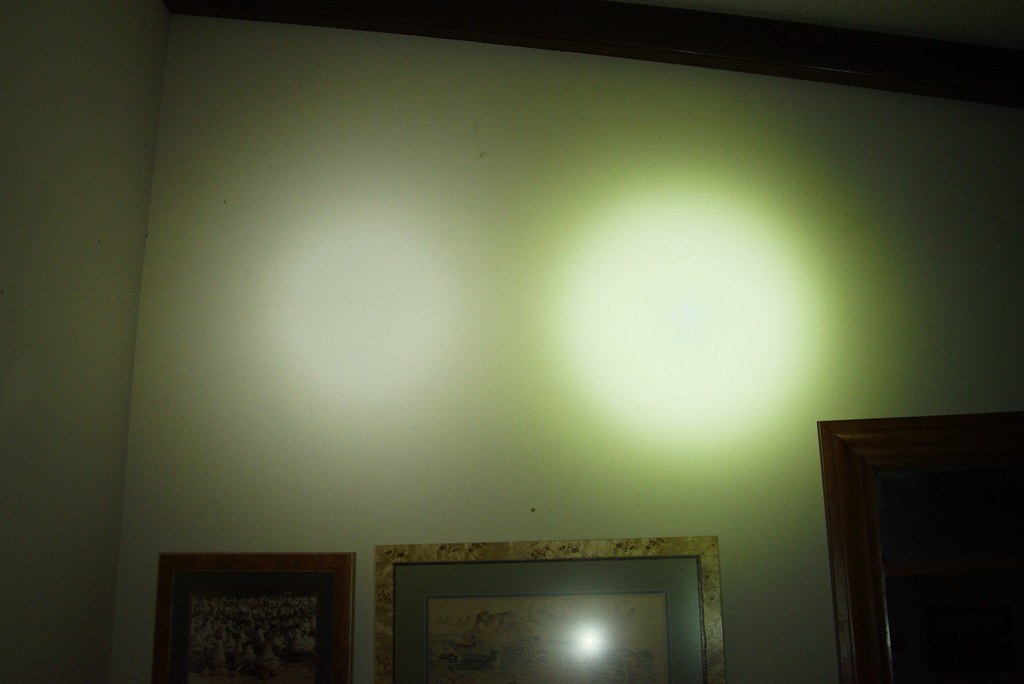
I need to find a good spot for outdoor beam shots to standardize on.
Lumens
The specs call for low 250 Lumens, Medium 1000 Lumens, and High 3500 Lumens.
I don’t have a calibrated light box, but I do have an uncalibrated box and a ceiling (for bouncing) to compare various lights.
On high, the HL 5-X (3500 Lumens) measures in the box at 3300
The Sophirn SP70 (on 3000 Lumen setting) measures 3030
Using the ceiling bounce and a light meter,
The SP70 (on 3000) Set to 0 on the meter). The HL 5-X is within a nates ass of an f/Stop.
So I wave my magic wand and call it 3200 Lumens and I used this as the max value for the runtime graphs.
On medium (1000 Lumens), The Box reads 910
On Low (250 Lumens), The Box reads 233
So it’s clearly in the ballpark of the factory specs. My measurements could easily be off by a good margin.
When the batteries get low the light starts the light just dims and doesn’t seem to have any low voltage protection. I have some crappy cells that I let run to 2.8v. I may run them down further to see if anything happens.
Conclusions
This is one stout feeling light. It is on the heavy side for duty belt carry (says someone who never wears a duty belt). The rubber coating makes for an excellent grip. The coating also makes it harder to clean if something nasty gets on it. The large ID battery tube lets the batteries rattle if the light is shaken hard.
The quality and color of the beam is not up to flashaholic standards (actually it sort of sucks). The target market for this light, I suspect, could care less. I wish there was a way inside to see if an LED swap could improve things.
The simple interface is good for non-flashaholics or BLFers not wanting all the magic modes.
I like the side button (only) control much better than the L6 that uses the side button for modes but must be turned off with the end button. Lights with two switches that can be turned off with both the tail cap and side switch, like the SP70, are much better that the L6 style in my opinion. On a light this size I think the single button is just fine. It’s a shame you can’t lock it out by unscrewing the tail cap.
So who’s it for? It falls into the area between a duty belt light and general purpose/search and rescue light.
For law enforcement, this would be a great light if the weight can be tolerated. A light as a first defense tool is certainly a consideration (as in drop the ticket book, whack ’em with the light, then pull the Taser).
I can see it on the belt of a night watchman type being used on low to light the way between dark areas and on high to peer into those dark corners if something goes bump in the night. The broader light will be an asset in this case.
Any job a 2xD cell Maglite does this could do better, thinks I. Neighborhood watch on foot or in a car would be right up HL 5s alley (so to speak). For a general use light in harsh conditions I think it fits the bill quite well.
I don’t see a firefighter type using this as the broader hot spot and cooler tint would reflect back at the user in smoky conditions. The same for EMS types who might be searching in rubble post building collapse. A thrower that can peer down crevices would seem the better choice (says someone who has done neither).
Used alone or in combo with a headlamp, it would certainly do for close/medium range search & rescue. It is not too heavy to be carried for extended periods of time. The rubber coating is way nicer to hang onto in cold weather with bare hands.
Something with more throw and runtime like the SP70 would do better for longer range searches.
There are so many choices these days. One can afford to be picky when it comes to choosing a light for any purpose. When I bought it the full asking price was over $100, now it seems that it’s selling in the low $70s for the 4x123 version (Sept, 2019). At 100 bucks, I’d pass unless I had a specific need for a simple UI heavy duty light. Even at $70, I’m not all that impressed. It’s hell for stout and simple to use, but that’s about it.
For about the same price - Sitting next to a BLF SP36 I’d grab the SP36 every time. Unless I knew I was going into some sort of high stress situation. Then the HL 5-X would be my choice.
I’d be pissed if I bricked the SP36 and couldn’t get another.
The Streamlight? Ehh not so much.
It would be a good choice to give to someone emergencies. Stick some protected cells inside and don’t tell them it goes brighter then low.
Anyone else who has this, does your light have the mean green tint?
All the Best,
Jeff